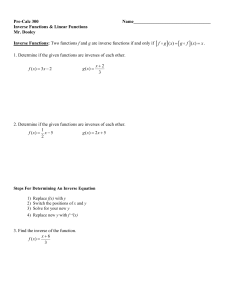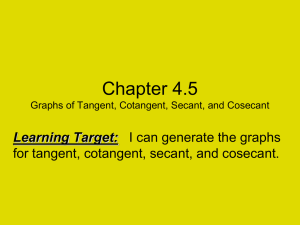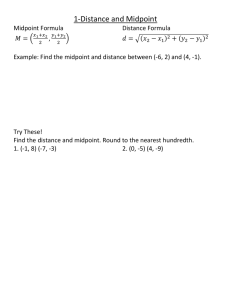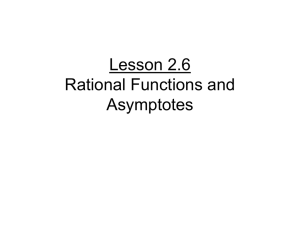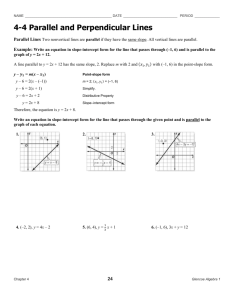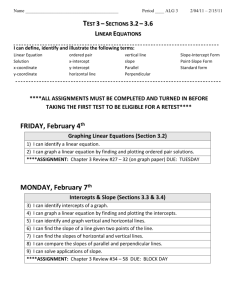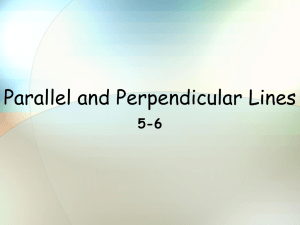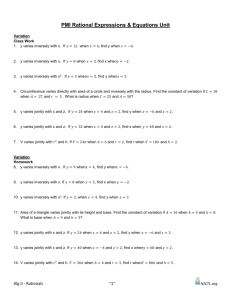Precalculus
advertisement
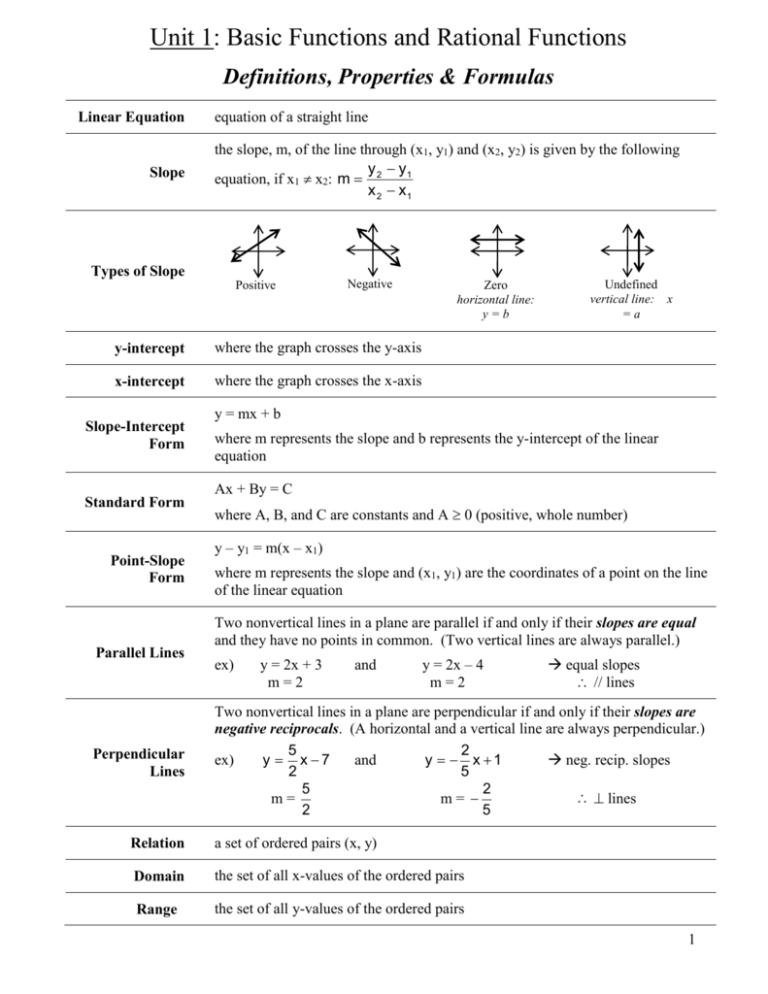
Unit 1: Basic Functions and Rational Functions Definitions, Properties & Formulas Linear Equation Slope equation of a straight line the slope, m, of the line through (x1, y1) and (x2, y2) is given by the following y y1 equation, if x1 x2: m 2 x 2 x1 y Types of Slope Positive y x Negative x y-intercept where the graph crosses the y-axis x-intercept where the graph crosses the x-axis Slope-Intercept Form Standard Form Point-Slope Form Parallel Lines Perpendicular Lines y y x Zero horizontal line: y=b x Undefined vertical line: x =a y = mx + b where m represents the slope and b represents the y-intercept of the linear equation Ax + By = C where A, B, and C are constants and A 0 (positive, whole number) y – y1 = m(x – x1) where m represents the slope and (x1, y1) are the coordinates of a point on the line of the linear equation Two nonvertical lines in a plane are parallel if and only if their slopes are equal and they have no points in common. (Two vertical lines are always parallel.) ex) y = 2x + 3 m=2 and y = 2x – 4 m=2 equal slopes // lines Two nonvertical lines in a plane are perpendicular if and only if their slopes are negative reciprocals. (A horizontal and a vertical line are always perpendicular.) 5 2 y x 7 y x 1 ex) and neg. recip. slopes 2 5 5 2 lines m= m= 5 2 Relation a set of ordered pairs (x, y) Domain the set of all x-values of the ordered pairs Range the set of all y-values of the ordered pairs 1 Function Vertical Line Test (VLT) Horizontal Line Test (HLT) One-to-One Functions Inverse Relations & Functions Writing Inverse Functions a relation in which each element of the domain is paired with exactly one element in the range. If any vertical line passes through two or more points on the graph of a relation, then it does not define a function. If any horizontal line passes through two or more points on the graph of a relation, then its inverse does not define a function. a function where each range element has a unique domain element (use HLT to determine) f -1(x) is the inverse of f(x), but f -1(x) may not be a function (use HLT to determine) To find f -1(x): (1) let f(x) = y (2) switch the x and y variables (3) solve for y (4) let y = f -1(x) Odd Functions symmetric with respect to the origin TEST: f(-x) = -f(x) Even Functions symmetric with respect to the y-axis TEST: f(-x) = f(x) Symmetry Tests Operations with Functions symmetric with respect to the: y-axis x-axis origin the given equation is equivalent when: x is replaced with -x y is replaced with –y x and y are replaced with –x and -y sum: (f + g)(x) = f(x) + g(x) difference: (f – g)(x) = f(x) – g(x) product: (f g)(x) = f(x) g(x) quotient: f f ( x) ( x ) , where g( x ) 0 g( x ) g 2 Composition of Functions Zeroes given functions f and g, the composite function is f g( x) f g( x) , where g(x) is substituted for x in the f(x) function set numerator equal to zero and solve Vertical Asymptotes set denominator equal to zero and solve for x (beware of the “hole” !) Horizontal Asymptotes Case: Horizontal Asymptote Oblique Asymptotes use long division to find the quotient of the numerator and denominator. Only works if m = n + 1 Point Discontinuities Factor the numerator and the denominator. Cancel the "like" factors (if any) Off on the side, set the cancelled factor equal to 0 and solve. This is the xvalue of the hole in the function. Plug the "x-value" into the simplified function and solve for y. This is the yvalue of the hole in the function. Graph the simplified function by finding zeroes, VAs, and HAs. Plot the location of the hole. Practical Domain a domain that makes sense within the context of the given problem (generally we avoid negative measures) mn y0 mn y am an mn none 3 Precalculus Review- Test- Basic Functions and Rational Functions Name:______________________________ Date:_______________________________ (1) Which of the following equations define functions? Explain your reasoning. (a) y = x + 6 (b) y2 = x + 1 (c) y3 = x + 4 (d) y = x – 2 (e) y3 = x – 3 (f) y2 = x – 5 (2) Which of the following functions are one-to-one? Explain your reasoning. (a) f(x) = x5 (b) g(x) = 2x + 7 (c) h(x) = x2 – 4 (3) Write the linear equation in standard form Ax + By = C that passes thru the points (3, 5) & (4, -3). (4) Write the linear equation in slope-intercept form y = mx + b that passes through the point (1, 3) and is parallel to the line 2x + 2y = 5. (5) Write the linear equation in slope-intercept form y = mx + b that passes through the point (1, 3) and is perpendicular to the line 3x – 3y = 4. (6) Write the linear equation in standard form Ax + By = C that is a horizontal line and passes through the point (-9, 2). (7) Given f(x) = 2x2 – x + 3 find f(k – 2) (8) Given f(x) = 4x – 7 and g(x) = 2x – x2, evaluate f(2) + g(-1) (9) For the function f(x) = -6x + 5, find and simplify: f ( x h) f ( x ) , h0 (a) h (b) f ( x ) f (a ) , x a 0 x a 4 __________________________________________________________________________________________ (10) Find the domain of each of the following: 2x 3 (a) f ( x ) 2x (b) g( x ) x 4 __________________________________________________________________________________________ (11) Algebraically determine the symmetry with respect to the y-axis, x-axis, and origin, if any exists, for each of the given equations: 2x 4 y 7 a) b) 9 x 2 4 y 2 36 __________________________________________________________________________________________ (12) Given f ( x) x 2 3 and g ( x) 2 x 4 , find f g (x) and g f (x) and give each domain. __________________________________________________________________________________________ For each of the following functions, f (x) , find the inverse, f 1 ( x) : f ( x) 5 x 2 a) 4 f ( x) b) x3 __________________________________________________________________________________________ y (14) Given the graph on the right, answer the following questions: (13) (a) write the linear equation in slope-intercept form: (b) write in slope-intercept form the equation of the parallel line through (2, -1) and graph: (c) x write in slope-intercept form the equation of the perpendicular line through the x-intercept and graph: __________________________________________________________________________________________ (15) Perform the four basic operations with the functions f(x) = 4x and g(x) = x2 + 2 (f + g)(x) = (f – g)(x) = (f g)(x) = f ( x ) g __________________________________________________________________________________________ 5 __________________________________________________________________________________________ (16) The Great Stride Shoe Company determines that the annual cost of making x pairs of one type of shoe is $30 per pair plus $100,000 in fixed overhead costs. Each pair of shoes that is manufactured is sold wholesale for $50. (a) Write a linear function C(x) that models the cost of producing x pairs of shoes. (b) Write a linear function R(x) that models the revenue produced from selling x pairs of shoes. (c) Find how many pairs of shoes must be made and sold in order to break even. (d) Sketch the graphs from parts (a) and (b) and indicate the WINDOW used. (e) Explain the graphical interpretation of your answer to part (c). __________________________________________________________________________________________ (17) Bermuda grass can be found in Africa and Asia, and has an amazing growth rate of 5.9 inches per day. Suppose you cut a Bermuda grass plant to a length of 2 inches. (a) Write a linear function L(x) that models the length of the plant after x days. (b) Using your function from (a), find the length of the plant if you didn’t cut it again for one week. __________________________________________________________________________________________ (18) A digital camera was purchased for $250 and is assumed to have a salvage value of $40 after 7 years. Its value has depreciated linearly during this period. (a) Write a linear function V(t) that relates the value of the camera in dollars to time t in years. (b) What would be the depreciated value of the camera after 2 years? 5 years? (c) What is the practical domain of the depreciation function? (d) Sketch the graph and indicate the WINDOW used. __________________________________________________________________________________________ 6 __________________________________________________________________________________________ (19) Identify the domain, zeroes, asymptotes, holes, and graph the function: __________________________________________________________________________________________ (20) Identify the domain, zeroes, asymptotes, holes, and graph the function: __________________________________________________________________________________________ (21) Identify the domain, zeroes, asymptotes, holes, and graph the function: __________________________________________________________________________________________ (22) Identify the domain, zeroes, asymptotes, holes, and graph the function: __________________________________________________________________________________________ (23) Identify the domain, zeroes, asymptotes, holes, and graph the function: __________________________________________________________________________________________ (24) A rectangular area of 100 square meters has a wall on one of its sides, as shown. The sides perpendicular to the wall are made of fencing that costs $40 per meter. The side parallel to the wall is made of decorative fencing that costs $50 per meter. a. Write a function to express the total cost, C(x), of the fencing as a function of x. b. Find the minimum cost to the nearest dollar. What are the dimensions that give this minimum cost to the nearest tenth? c. Sketch the graph and indicate the WINDOW used. x L L x __________________________________________________________________________________________ 7

